
***navigation.shtml***

Repotting
Cymbidium -
|
|||
Repotting Cymbidiums - transplanting into hydroponics - is well worth the effort. Cymbidiums love our system! In nature, cymbidiums grow on rocks and trees with their roots exposed to the elements. That means cymbidiums growing in pots need a media that doesn't hold water and drains quickly. This type of growing media can make watering tricky and overwatering is a common problem. Then, if you're not careful, underwatering becomes an problem! Our Hydroponic System makes correct watering easy. It all has to do with how you setup the hydroponic system. After transferring your cymbidiums to hydroponics, go over to Hydroponics for Outdoors - Setting Up Cymbidiums and see how to setup your plants for outdoor growing. |
|||
| The best time for
transplanting
cymbidiums is late spring or early
summer - just before taking them outside for the summer. Let's get started .... |
|||
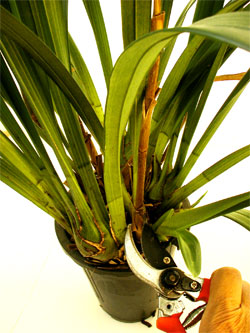 |
1. Remove the dead flower stems. Using a sharp pruners, cut the flower stem off at the base of the plant. | ||
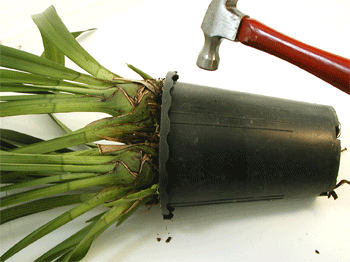 |
Cymbidiums like to be crowded in the pot so removing the plant from its existing pot can be a challenge. Gently tap the pot with a hammer to loosen the roots. | ||
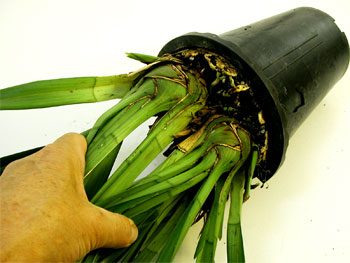 |
Grasp the plant and firmly pull upward. These plants have thick, sturdy leaves so they can withstand a strong tug. If the plant and container won't separate, cut the pot with a utility knife. (Always use clean tools when working with orchids.) | ||
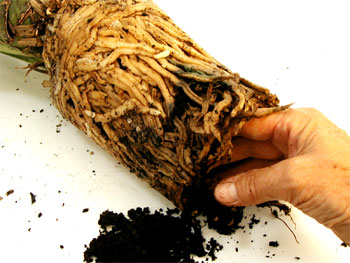 |
Notice
the large, complex root system. Removing the existing
growing media can take some time. Soaking the
rootball for a couple of hours (or overnight) will make it more
cooperative. Tip: I've learned that tearing the roots apart just to get that last bit of bark or moss out isn't necessary. These plants have no problems adapting to hydroponics even if you leave some planting materials buried inside the root ball. |
||
 |
Pull roots apart wherever possible. Be aggressive. Dig in with your fingers. Keep digging and pulling. If you hear a snapping sound, a root broke so back off a little. Chop sticks make excellent tools for poking around between the roots. | ||
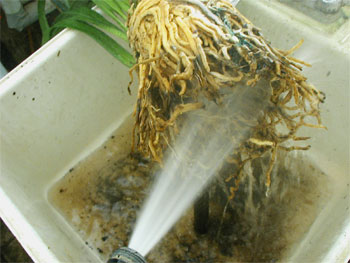 |
Wash away all bark and moss between the roots. You're going to need a garden hose for this. Water from the tap just doesn't have enough pressure to get in between those thick roots. Sometimes cutting the rootball is the only way to get inside. | ||
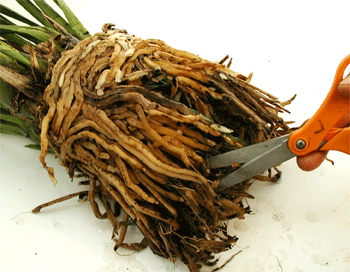 |
Using a clean, sharp scissors, remove all decaying roots. Healthy roots are white or pale yellow and firm. Brown, soft roots are decayed and should be removed. Some root loss is normal. Be aggressive - new hydroponic roots will grow back quickly. | ||
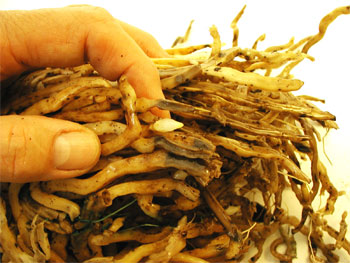 |
Careful! A white tip at the end of a root is means active growth. Try not to damage new growth tips. | ||
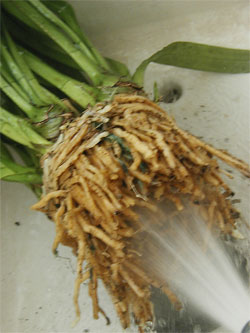 |
Back to the sink for more washing. Notice the smaller root ball this time around. | ||
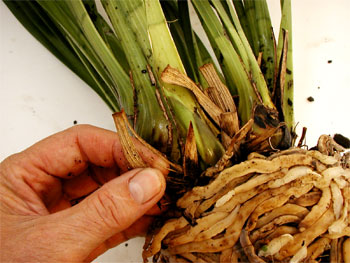 |
Now is a good idea to remove the sheaths around the psuedo bulbs too. Insects like to hide behind them (most likely scale). | ||
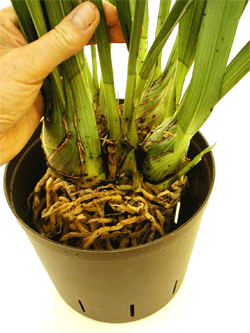 |
Choose
a new culture pot that allows for 1-2" of room all sides. |
||
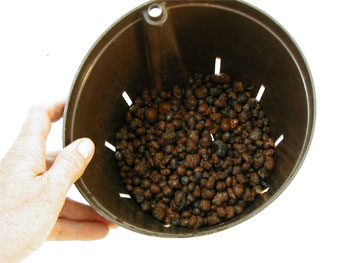 |
Cover bottom with about 1/2" of pebbles. | ||
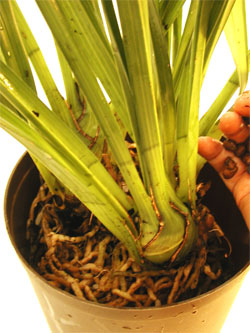 |
Postion plant and fill with pebbles. | ||
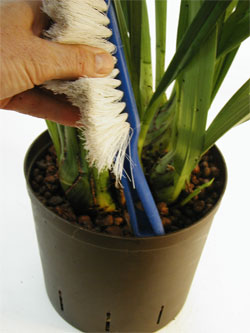 |
Tap down pebbles. Be aggressive here. Don't leave any air gaps around the root system. | ||
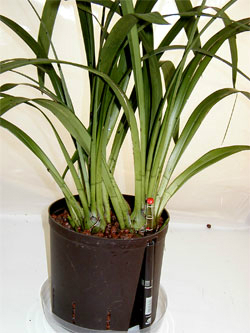 |
Here's our new plant. As you can see, we're not using an outer pot. This plant is going outside for the summer and it's setup for outdoor growing. See Hydroponics for Outdoors - Setting Up Cymbidiums for more on this. | ||
Repotting Cymbidiums in the Future |
|||
With hydroponics, repotting to simply replace old growing media is unnecessary. LECA pebbles never breakdown or decay like other growing media so they never have to be replaced (big advantage!). The only time repotting is necessary is when the plant's roots have burst through the culture pot. When this happens, simply remove the plant from its existing pot and transfer the entire root ball to the larger pot. No need poke around to remove old potting materials (lot easier than removing old decaying bark!). The (LECA) pebbles buried inside the root ball are ceramic and they're as good as new. |
|||
Plant Care for Cymbidium Orchids Hydroponics for Outdoors - Setting Up Cymbidiums |
|||
***footer.shtml***